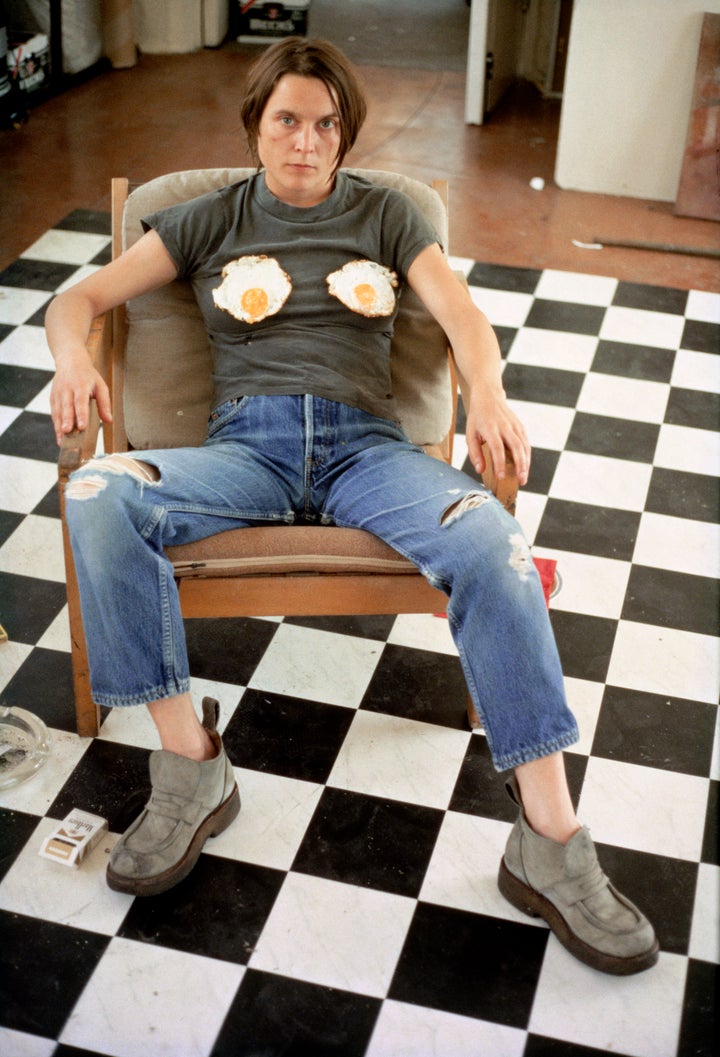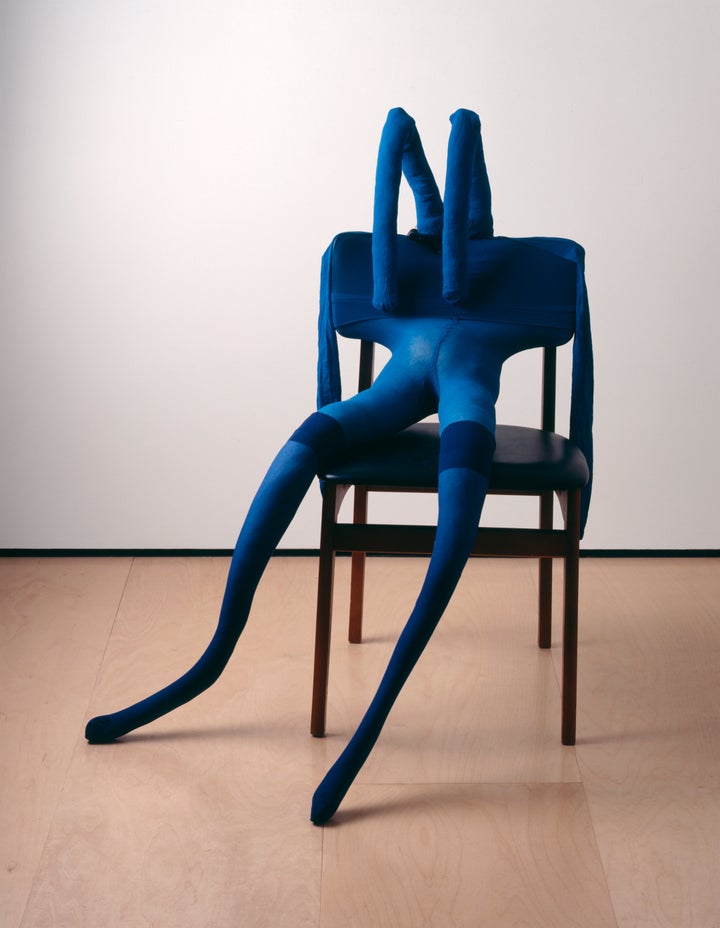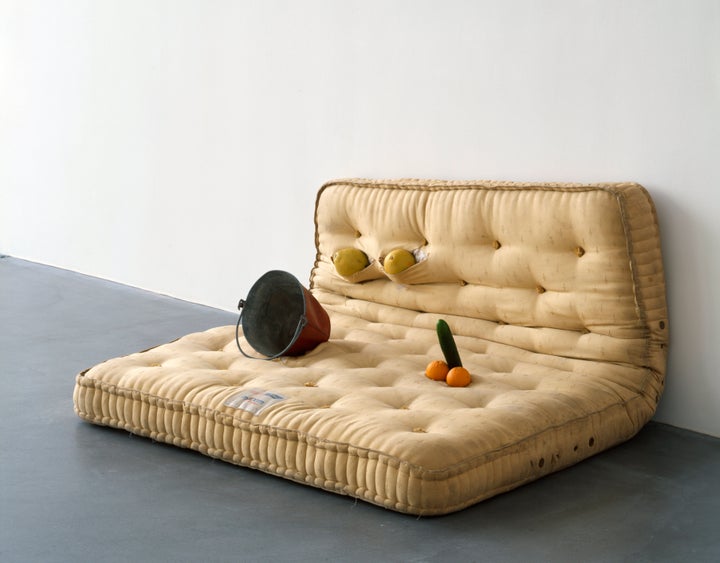
NEW YORK ― “That is Sarah Lucas’ crotch,” I thought, as I stepped off the elevator on the fourth floor of the New Museum.
I was staring at a photograph of the artist plastered floor-to-ceiling on the wall opposite me. In it she’s reclining, wearing blue jeans, a white T-shirt, a brown leather jacket and Blundstone boots. Her spread legs conjoin right at eye level. Her face looks quizzical and unimpressed, as if she wasn’t expecting anyone to intrude on her moment of relaxation, especially not someone as lame as me.
Lucas, 55, is known for her feminist convictions, her punchy sense of humor, her subversion and perversion of domestic materials. And her love of eggs. But I’m here to talk about something else: her slouch. And mine. And all the women whose spines prefer to exist in curvature.
A slouch, Merriam-Webster tells us, is “a gait or posture characterized by an ungainly stooping of the head and shoulders or excessive relaxation of body muscles.” It’s also slang for “a lazy or incompetent person.” But take one look at Lucas — her person and her work — and the posture’s association with slovenly underachievement melts away. Lucas’ slouch doesn’t communicate laziness or indecision. She seems casual and without pretense, yet still very much in control: the kind of person who doesn’t fret about re-organizing her bedroom closet or differentiating between flat and curly-leaf parsley because she has bigger fish to fry.

Born in 1962 in the inner-city London district of Holloway, Lucas became famous in the 1990s for her association with the “Young British Artists” crowd ― people like Tracy Emin, Damien Hirst and Chris Ofili who rose to prominence in the city’s warehouses and factories through a savvy combination of enfant terrible tactics and a flair for branding. In the years since, Lucas has become an enduring figure in the British art scene, her irreverent oeuvre spanning sculpture, photography and installation. Over the decades, she’s maintained an eye for beauty in regular or even unseemly spaces and a deviant sense of humor. Remarkably, the collection at the New Museum marks Lucas’ first solo exhibition in the U.S.
That exhibition is full of stellar slouching moments. In self-portraits, Lucas slouches with aviators on, with cigarettes and coffee in hand, hunched over a skull. She slouches in a chair with two fried eggs placed atop her breasts. Every time, her hawk-like gaze drills into the viewer’s, as if daring them to suggest that she stand up straight.
Inanimate objects, too, get in on the fun. In the 1997 series “Bunny Gets Snookered,” stuffed, tan tights imitating human legs sag against plywood chairs. The alien figures push beyond hunching; the mushy materials are slouch incarnate.
The title of the exhibit, “Au Naturel,” is a nod to art historical depictions of female nudes. These muses are usually depicted in repose, as if just waking up from the world’s most flattering nap. If not, they’re particularly posed to accentuate their lithe physiques. If you’re a woman set to be immortalized in paint, art history tells us, you should be frozen unconscious ― or appear permanently stuck in good posture, at least.
The show’s titular piece is a yellowing mattress resting on the floor, shoved up against the wall, its curvature resembling a back that’s given up. Two melons that look unmistakably like boobs appear on one side above an outward-facing bucket. Nearby sit two oranges and a pert cucumber ― cock and balls, of course. They allude to a sexuality that’s at once infantile and, er, ripe. They’re radical in all their proudly unbecoming glory. Immodest but not seductive, neither particularly masculine nor feminine, they are simply what they are: easy, comfortable, in your face.
The show is littered with body parts — tits and vags and dicks, the last because her partner Julian Miller “likes having his nob cast.” Some of the plaster phalluses are hardened to full attention, but others soften and slump, a compelling alternative to masculinity’s typical image of rigidity and brute strength.

Critics typically characterize Lucas as the “brashest angriest baddest drunkest most in-your-face girl of the YBAs,” as Maggie Nelson jokingly summarizes in the exhibition catalogue. Lucas herself is befuddled by the description, saying her work isn’t as “‘fuck off’ as other people seem to take it.” Maybe critics, not used to seeing women in positions other than pose and repose, mistook her posture for one of hardness. But really, Lucas’ work luxuriates in softness — of bodies, domestic spaces, disposable materials — only occasionally puncturing it with an intrusion of something sharp. It is less a posture of “fuck off” and more a posture of “I don’t give a fuck what you think.”
Defiant slumping dates back at least to 1913 with the “debutante slouch,” a self-conscious craze (documented around the time by the Library of Congress and The New York Times) used to describe women of all classes who walked with their “shoulders sloping, chest dropped, hips slung forward and the knees... slightly bent.” For many, the posture went hand in hand with women drinking, smoking and casting corsets aside; it was something to be medically advised against. For others, it was a signifier of imperfect change, of (mostly white) women finally harnessing defiance, vying for jobs in male-dominated fields and protesting for the right to vote, slouch-shaming be damned.
In recent years, celebrities like Kristen Stewart, Emma Watson and Keira Knightley have inspired tsk-tsking tabloid headlines for their refusal to assume classic starlet stances on carpets. And in case you needed any additional evidence that slouching is a good thing, Jordan Peterson advises against it.
As someone who has the posture of Eeyore holding a smartphone, Lucas’ devotion to slouch life hits me where it aches (in my lower spine). I have only felt shame in relation to my posture, perceiving it as a sign of my indefatigable fatigue and inability to function in even the most basic of ways. I’d never considered that a slouch could be something to be proud of, a way of wordlessly communicating some form of BDE.
In the shoulders of Lucas, slouching is the posture of making bad jokes but not laughing at them, of making a mess of your things but not of your work, of showing too much of yourself and not the “pretty” parts. Slouching is the posture of having nothing to prove to anyone but yourself.
